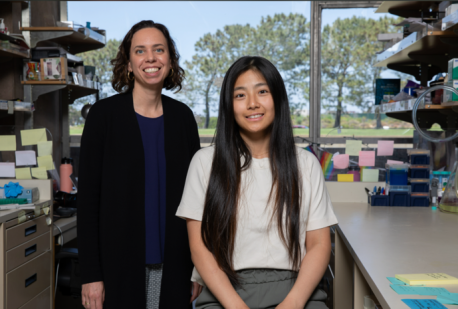
June 5, 2024
Salk scientists determine how three variants of a protein complex coordinate pathogen-specific immune responses in mice; findings may lead to new therapeutics for inflammation
Salk scientists determine how three variants of a protein complex coordinate pathogen-specific immune responses in mice; findings may lead to new therapeutics for inflammation
LA JOLLA—Bacteria, parasites, viruses—the immune system tackles them all. At the front line of the human immune response are cells called macrophages, which are responsible for correctly identifying intruders and then directing how the entire immune system responds. Researchers at the Salk Institute have now discovered a molecular mechanism that helps macrophages mount a coordinated response tailored to a specific immune challenge.
Activating macrophages requires the work of three versions of a protein complex called SWI/SNF: cBAF, ncBAF, and PBAF. Scientists already knew these variants had slightly different structures, but the new findings reveal that these differences have real functional consequences. Salk researchers discovered that each variant plays a distinct role in initiating macrophages’ responses to intruders and, consequently, how the immune system regulates inflammation.

By delineating these SWI/SNF variants, the team has revealed new immune system mechanisms that could be targeted with therapeutics to regulate inflammation associated with conditions like sepsis, cytokine storm, COVID-19, and many more.
The findings were published in Immunity on June 5, 2024.
“Macrophages are our first line of defense and the recruiters for adaptive immune cells, so understanding how they work is key to understanding our immune response,” says Diana Hargreaves, senior author and associate professor at Salk. “If we can figure out how macrophages tailor their responses to a given immune signal, we’ll have a better idea of how we can therapeutically target them to create desirable immune system behaviors.”
Macrophages are the first to sense an intruder in the body, so it is their responsibility to accurately identify the intruder and instruct the rest of the immune system’s response. To ensure that the correct response is mounted, macrophages require very specific internal signaling.
Each macrophage contains a set of identity-forming instructions encoded in strands of DNA, which are wrapped around protein complexes called histones and then wound into a 3D structure called chromatin. Changes to histones and chromatin impact the identity of a cell, since their modifications can expose or conceal stretches of DNA responsible for the cell’s behavior.

The SWI/SNF protein complex was already known to carry out such changes, but it was unclear whether each of the three variants did so in a unique way or led to distinct macrophage behavior. To learn more about the SWI/SNF variants, the researchers observed how macrophages in mice responded to bacterial infection and paid close attention to differences among cBAF, ncBAF, and PBAF activity.
"We found the SWI/SNF variants each serve a unique, important purpose in reorganizing chromatin across the genome and enabling macrophage inflammatory responses,” says first author Jingwen Liao, a graduate student in Hargreaves’ lab. “This is a major leap in our understanding of how immune systems respond with such a high level of specificity.”
When confronted with a bacterial threat, each of the three SWI/SNF variants regulated distinct portions of the macrophages’ DNA, producing distinct cellular responses. cBAF remodeled chromatin to promote inflammation, while ncBAF modified histones to stimulate an antiviral response. PBAF also modified histones, but the result of those modifications was less clear than cBAF or ncBAF.
The three acted distinctly and cooperatively to coordinate a complicated immune response that calls on the rest of the immune system to effectively and efficiently rid the body of threats.
“Chronic inflammation is a major cause of mortality across many diseases,” says Hargreaves. “When patients succumb to COVID, for example, that’s often a product of inflammation. This makes our findings really exciting, because we’ve found a new way to potentially toggle the immune system’s inflammatory pathways to improve outcomes in patients with chronic inflammation.”
The team will continue to study the effects of histone modification by PBAF in follow-up research. Given that cBAF and ncBAF inhibitors are already in clinical trials for cancer treatment, Hargreaves is optimistic about translating their findings into future drugs for chronic inflammation.
Other authors include Josephine Ho and Mannix Burns at Salk, as well as Emily Dykhuizen at Purdue University.
The work was supported by the National Institutes of Health (NCI CCSG: P30 014195, AI151123, GM128943, R21 MH128678-01), Pew-Stewart Scholars for Cancer Research, and the American Cancer Society.
DOI: 10.1016/j.immuni.2024.05.008
JOURNAL
Immunity
AUTHORS
Jingwen Liao, Josephine Ho, Mannix Burns, Emily C. Dykhuizen, Diana C. Hargreaves
Office of Communications
Tel: (858) 453-4100
press@salk.edu
Unlocking the secrets of life itself is the driving force behind the Salk Institute. Our team of world-class, award-winning scientists pushes the boundaries of knowledge in areas such as neuroscience, cancer research, aging, immunobiology, plant biology, computational biology and more. Founded by Jonas Salk, developer of the first safe and effective polio vaccine, the Institute is an independent, nonprofit research organization and architectural landmark: small by choice, intimate by nature, and fearless in the face of any challenge.